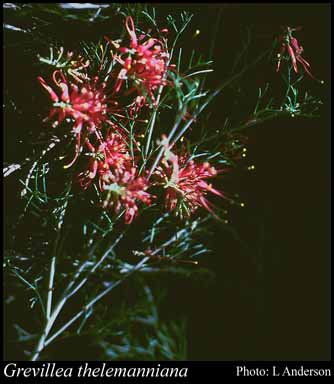- Reference
- Endl. & Fenzl, Nov.Stirp.Dec. 1:6 (1839)
- Conservation Code
-
Threatened
A taxon name retains its ‘Threatened’ status until a new name has been officially endorsed and appears in the Gazettal Notice.
- Naturalised Status
- Native to Western Australia
- Name Status
- Current
Spreading, lignotuberous shrub, 0.3-1.5 m high. Fl. pink-red, May to Nov. Sand, sandy clay. Winter-wet low-lying flats.

Scientific Description
Shrubs, 0.5-1 m high; branchlets glabrous or hairy, not glaucous. Leaves alternate, 10-30 mm long, 1-1.5 mm wide, hairy, on the abaxial surface, the hairs straight; lamina flat, once divided, tripartitely divided, divided to the midrib; lobes 2-8 mm long, 0.5-1.5 mm wide, the margins recurved, exposing the lower surface of the leaf blade, forming a groove either side of the midvein. Inflorescences terminal, red or pink; pedicels 3-4 mm long. Perianth 7-9 mm long; tepals some joined and some free after flower opens, glabrous; ovary glabrous, stipitate, the stipe 2.5-4 mm long; pistil 18-22 mm long, red, pollen presenter oblique, style glabrous. Follicles glabrous, not viscid, dehiscent, 12-13 mm long. Flowers in July, August, September or October. Occurs in the South-west (SW) Botanical Province(s), in the Swan Coastal Plain (SWA) or Jarrah Forest (JF) IBRA subregion(s). : Conservation code Threatened (T) or Priority Four (P4).
Distribution
- IBRA Regions
- Swan Coastal Plain.
- IBRA Subregions
- Perth.
- Local Government Areas (LGAs)
- Canning, East Fremantle, Gosnells.